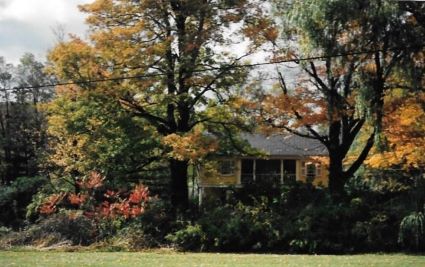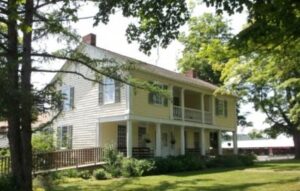Gregory Inn/Mitchell House History

Gregory Inn/Mitchell House History
In 1821 land was deeded and acquired by Daniel and Gehial Gregory that was just north of Troy, Pa. The Gregory Inn and Tavern was built in 1822 and catered mostly to stage coach travelers destined for Elmira, New York or Williamsport, Pennsylvania. When the railroad was built in the 1850’s the Inn saw an increase in clients served.
In 1839 the property was purchased by Dr. Alfred Parsons who named his farmland Alparon Park. Due to the noise, soot and sparks from the railroad, Dr. Parsons moved and the house became a tenant house. There were several owners of this property one being John A. Parsons and in 1882 he leased 66 acres of the beautiful farm grounds to the Troy Fair. It did not include the the house. The Carraige House was added to the grounds for the Fair around 1913. Check out the Carraige House to see how it again was moved to become part of the Heritage Village and Farm Museum.
In 1954 the Troy community businesses and several clubs joined together to provide a board and became a non profit corporation known as Alparon Community Park Association. The Troy Borough Municipal Authority took over legal ownership of Alparon Park except for the one acre occupied by the Mitchell’s House.
 Mitchell House
Mitchell House
The former Gregory Inn was bought in 1926 by Budd and Florence Mitchell who lived in this house as their personal residence. Budd and Florence love antiques and kept their home much as it was in 1936 when they moved in. Their home was a favorite Friday evening gathering of friends, family and community. When Budd and Florence passed away their sons offerred to sell the house to become an addition to the Farm Museum and Alparon Park for an affordable price. Through community support and various funding sources, the purchase was finalized in 1996. As per the family wishes the restoration began. The Mitchell House is part of the Heritage Village and Farm Museum and currently houses era specific furnishings from the 1800’s.
The Mitchell House was thought to be part of the underground railroad due to some findings by the Mitchell’s when their lost cat revealed a secret. There were several houses in the Troy area that were stops along the underground railroad. People would offer safe hiding places for slaves to be during the day and were far enough apart that slaves could travel during the night time hours to reach another stop in their quest for freedom. These stops were operated from 1831 until the end of the Civil War.
The house still has the origional woodwork, iron door latches, glass windows and a second floor ballroom that was also used as a men’s dorm for overnight guests. Once it became a part of The Heritage Village and Farm Museum, gardens were planted and are maintained by the Troy Ladies Garden Club. Guided tours are avialiable and the Heritage Village and Farm Museum also host special events here such as Ladies Tea’s.
